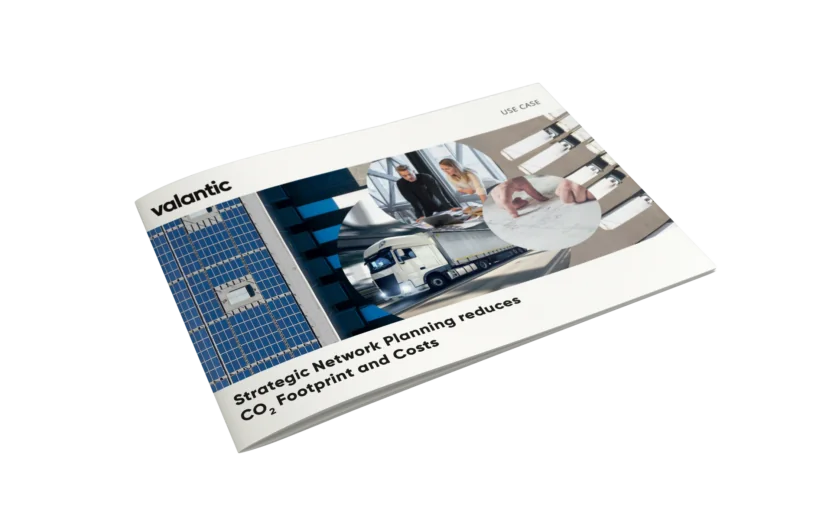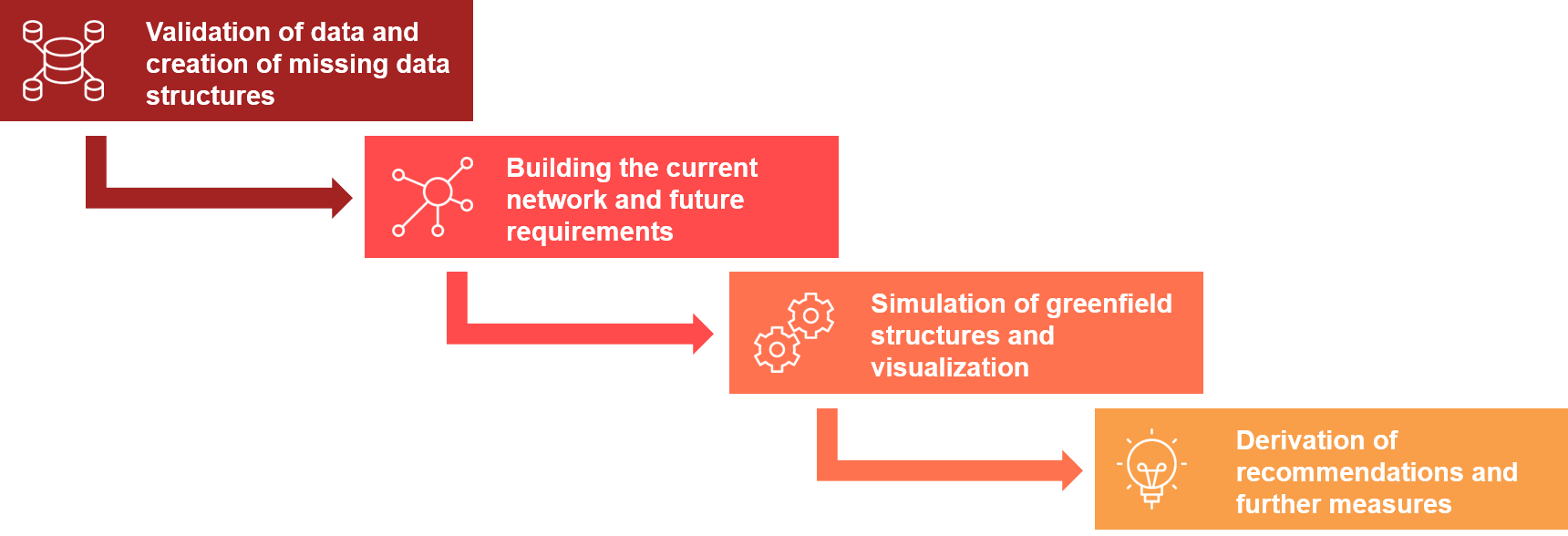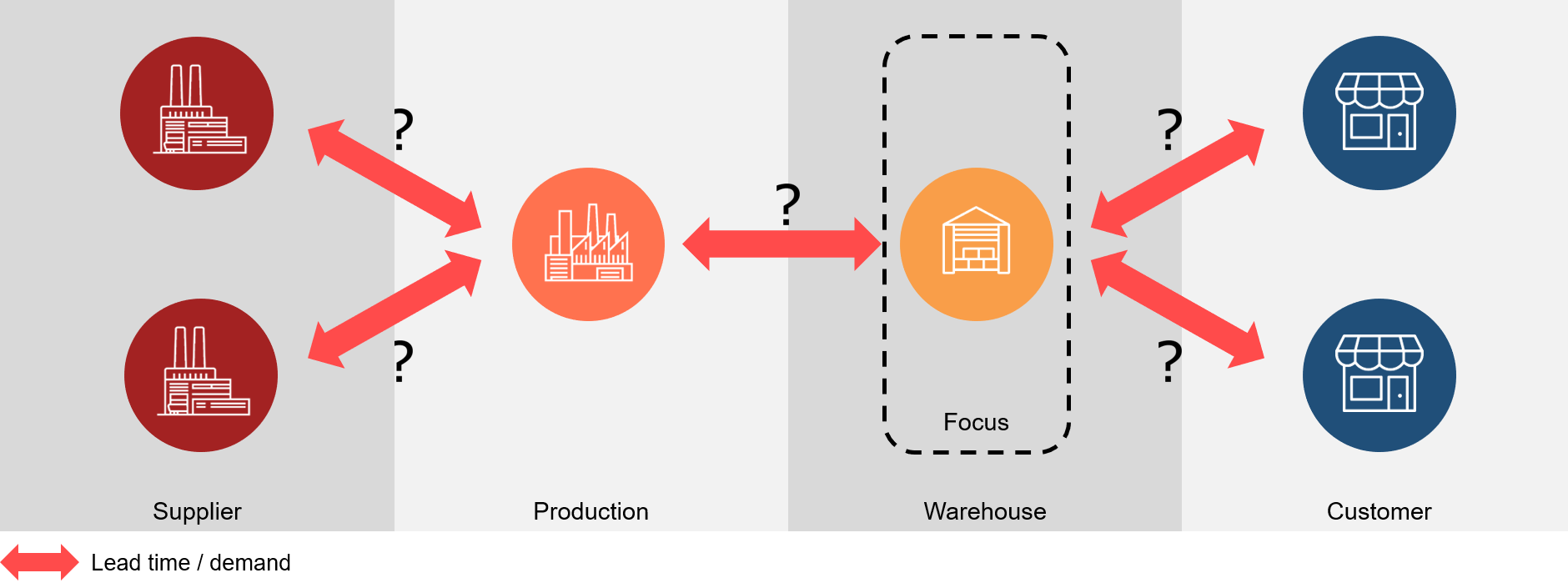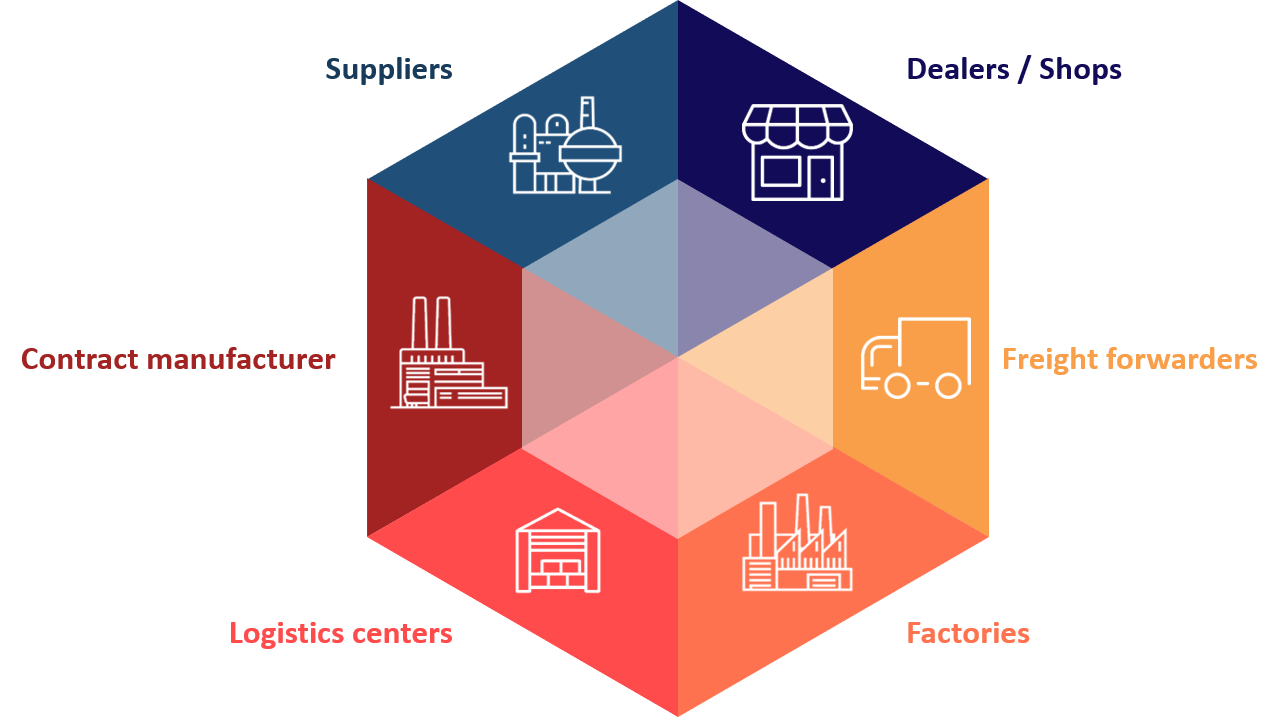Highlight

Successful together – our valantic Team.
Meet the people who bring passion and accountability to driving success at valantic.
Get to know usSupply Chain & Logistics
The dynamics of global markets make supply chain management a complex task. Constant changes require quick, well-informed decisions to avoid inefficiencies and ensure competitiveness. With logistics planning and our logistics services, valantic supports companies in supply chain design by creating transparency, optimizing logistics costs, and redesigning logistics networks according to individual requirements.

High-quality planning results and efficient project handling
Designing value chains is a complex, ongoing process in today’s quickly changing world. New possibilities, products, and markets, as well as increasing customer expectations mean that daily business changes very rapidly. Isolated decisions in supply chain design create inefficiencies within value-creation networks, which amplify one another. In order to prevent this and to be able to successfully meet the challenges, fast and resilient decision-making is necessary.
That’s why our consulting experts combine many years’ experience with high-performance planning software. This way it is possible to link best practice approaches to innovative ideas and assess alternatives for action quickly and objectively. With logistics planning & logistics services, valantic supports companies in supply chain design to create transparency, optimize logistics costs and redesign logistics networks according to individual requirements. As a customer, you will profit from effective planning results and efficient project handling.

Use Case: Strategic Network Planning
Learn more about how strategic network planning can reduce CO2-Footprint and Costs in our use case!
Network design (greenfield)
Changing logistics networks
Our world is subject to constant change, as are companies and their flows of goods. Due to expanded sales markets and innovative products in new markets, it is necessary to keep an eye on your own logistics networks and ensure that they are up-to-date. Classically, these are problems especially for very large companies and corporate groups. But in the meantime, even medium-sized companies are experiencing the challenges of a globalized world more frequently.
Due to this development, it is critical for companies to actively design their logistics structures and prepare themselves for new challenges and requirements. For example, this might include planning a new warehouse for better supply of target customers or identifying one or more optimal locations for a new production facility.
Comprehensive planning with the greenfield process
The so-called greenfield approach is frequently best for such problems. In contrast to brownfield planning, which re-plans existing structures, optimizing and adjusting them as required (see network optimization brownfield), the goal of greenfield planning is to define and plan new structures. On the one hand, this procedure offers the advantage that different variants can be tried out and then combined with the existing network. On the other hand, it ensures that the optimal solution for the problem is defined. Further down the road, the optimal solution can be adjusted step by step to real conditions.
The challenges of this approach are its complexity and the interplay of numerous variables. For example, geographic data, capacity and production restrictions, and fluctuating demand figures can play a role here.
That’s why we work with our customers in an iterative process to formulate the best possible solution for their individual challenges in the supply chain design.

Your benefits
Comprehensive planning approach for the identification and exploitation of optimization potential
Visualization of the current network and possible scenarios
Efficient, transparent analysis and evaluation of potential
Implementierung eines Standardvorgehens zur Netzwerkplanung in der Organisation
Network optimization (brownfield)
Checking the status quo
Supply chains are many companies’ backbone in today’s globalized economy. That’s why in the meantime, there is more focus on the correct design of supply chains. But even if supply chains have proven robust and resistant in the past, this doesn’t mean that they are optimally prepared for future challenges. Due to the constant, rapid growth of value chains, requirements with regard to flexibility and cost efficiency are also increasing, which can generate enormous optimization potential in established concepts.
Exploiting potential in ongoing operation
To identify this potential as quickly as possible in ongoing operation, frequently a brownfield optimization of the network will fit the bill. Here, in contrast to the complete new planning of the network (see network design greenfield), optimization potential in the existing structure is determined, evaluated, and exploited. The benefits of this procedure are on the one hand, the shorter time line and smaller amount of project work for identifying potential; on the other hand, the possibility to examine specific aspects and areas of the network individually. However, the big picture of optimizations should not be overlooked, otherwise this leads to silo thinking.
For decision-making, a comparison of the current network with various simulated variants is a good idea
The starting point for a successful network optimization project is the recording and analysis of relevant parameters that underlie the current network. Here and there, there are gaps in the data, so that the missing data has to be defined jointly. Current supply chains can then be built based on this data structure. Thanks to the transparent revelation of all supply relationships, initial optimization potential can be identified. In addition, thanks to their many years of practical and project experience, our consultants can uncover specific improvement possibilities.
Now all applicable options in the current network can be integrated step by step as the basis for a decision-making process. Then the model runs through numerous simulation loops in order to provide a quantitative evaluation of the measures’ effects. The decision-making process is thus faster, supported, and designed objectively, which results in increased acceptance across all levels.
Your benefits
Verification and preparation of your planning data as well as establishment of methods for collecting missing information
Visualization of the current network and possible scenarios
Transparent decision-making and recommendation of measures, as well as derivation of the next steps
Anchoring of the methodology in the company's organization
Transport planning and optimization
Do we still need transport?
The overwhelming majority of companies in Germany and Europe are active in industries and areas that manufacture physical products. Although there is significant growth in non-physical products such as software and services, there is no substitute for most physical goods. That’s why transport remains central to our economic system.
Transport planning on all levels
That’s why transport planning is a central issue for corporate management. Due to the significance of this topic, its influence extends across all planning levels. This way, companies can design transport on a strategic level, refine their planning on a tactical level, and control it in daily business on the operative level. Because it is so complex, many companies tend to outsource transport planning or implement a standard approach. But there is significant optimization potential precisely in the area of transport planning, which can be used to reduce financial burdens and personnel expenditures.
How sustainable are our transport networks?
In addition to the time and money factors, the topic of sustainability is also becoming increasingly important to companies. By its nature, transport is responsible for a huge quantity of CO2 emissions. That’s why in the coming years, there will be charges for each ton of CO2 generated. And that’s why it makes sense for companies to incorporate sustainability into their transport planning.
Transport planning includes a lot of topics that directly influence efficiency and a company’s success.
The goal of route planning is to make deliveries in time and cost-optimized fashion. The problem is largely similar to the famous “traveling salesman problem.” The complexity of route planning increases disproportionately with a larger number of partners. In particular, time window planning and the design of optimal routes are the greatest challenges.
Sustainability is a key topic of our era. It can be the basis for customers’ purchasing decisions and a financial burden for companies. Regarded and applied correctly, however, sustainability can also present an opportunity for many companies. That’s why the CO2 emissions from transport logistics and the optimal utilization of means of transport have to be considered in transport planning from the very beginning.
The selection of the right means of transport is crucial. Incorrect decisions can cause interruptions in the supply chain, which in the worst case cause production breakdowns. Here, strategic and operative decisions can also deviate from one another in bottleneck situations. To be able to make the right decision, the greatest possible transparency is required at all times.
With fleet management, the concern for companies is to plan their own and external capacities optimally into transport logistics. Here, topics range from strategic questions such as the selection of the right transport provider to operative aspects such as capacity management of the company’s own transport logistics.
With our proven consulting approach, we can help you with these problems and challenges in supply chain design. Together, we will analyze and visualize your current transport volume and network. Then we will analyze your network using a framework with specified premises and determine potential for the optimal control of your transport.
This is how we can help you on all levels in supply chain design, from strategic to operative planning and control of your transport.
Your benefits
Comprehensive examination of all relevant planning topics taking into account mutual dependencies
Establishment of the concept of sustainability in route planning
Visualization of transport streams to identify weak points and derive measures
Every company’s challenge is to adjust its order volume to current customer requirements. This challenge directly affects the company’s success. Within inventory optimization, therefore, companies strive to align their offerings and current warehouse inventories more efficiently to anticipated customer demand.
Optimal inventories differ sharply depending on the industry and company. Low inventory levels with the highest possible level of service represents a competitive advantage that cannot be underestimated. Here, it is important for companies to keep inventories as low as possible and to sell them as quickly as possible. Due to the much shorter planning intervals and number of warehouse locations within the whole supply chain, already-low demand fluctuations can have an enormous influence on warehouse inventories, which is reflected in the so-called “bull-whip effect.” This effect tempts many companies to make greater changes to inventories than are actually necessary and poses the challenge of fulfilling customer demand at the lowest possible cost in many industries. In inventory optimization, there is a distinction between single-level and multi-level optimization.
In single-stage inventory optimization, the focus is on improving inventory levels within a stage, e.g. a distribution center. Either the outgoing or incoming material flows are used as a planning basis. The goal of single-stage inventory optimization is to adjust the respective inventory types, e.g. the safety stock, in such a way that an optimal service level is achieved for the stage, without considering the other stages of a supply chain. For this reason, this methodology is more suitable for smaller networks that do not have a large number of different levels within the supply chain.

Fokus in einer einstufigen Bestandsoptimierung
For multi-level inventory optimization, inventories are examined comprehensively across the entire supply chain, which means that the effects of inventories on one level can directly influence the previous or next level. That’s why both incoming and outgoing material flows are examined in multi-level optimization. Thanks to frequently hidden interdependencies on supply chain levels and the different parties involved, continuous communication and coordination is extremely important. The goal of multi-level optimization is to achieve the desired service level for end customers with minimal inventories on various levels and thus increase the company’s success overall.

Relevant levels in multi-level inventory optimization
Supply chain resiliency
In our opinion, the topic of supply chain resiliency has become more important recently. Due to rapid globalization and the accompanying increase of potential risks for companies and supply chains, this topic will remain decisive for companies’ success in the future.
In the business context, resiliency refers to companies’ ability to withstand resistance and assert themselves against harmful influences. That’s why potential dangers and influences have to be recognized proactively, so that companies can prepare themselves.
valantic can help you with this. Together, we will conduct risk and what-if analyses with which possible challenges in your supply chain design can be evaluated. Building on this, we will work with you to develop proactive measures so that your company is well-prepared for possible risks and you can look into the future with confidence.
Your benefits
Standardized, transparent procedure for determining potential risks in your supply chain
Establishment of scenario-specific measure catalogs for application in case of risk
Proactive and long-term assurance of company success in case of disturbances
Sensitization of the company to potential disruptive events
Detect and avoid direct risks
Risk analyses are an elementary component of the tactical and operative planning of networks and examine potential operational results. The heart of the matter is to identify internal risks and risks that the company can influence directly, to assess these, and take countermeasures. The events to be examined are primarily relevant for the affected company, however they do not necessarily have to affect other companies or industries. This aspect is a clear characteristic for the distinction between analyses and what-if analyses.
Challenges of this type are many and varied and companies face them every day. This can be reflected in a supplier’s late or missing trucks, for example. However, there may also be production bottlenecks at a supplier or strikes. All of these are events that occur suddenly and in the worst case, put the entire supply chain to the test.
Proactive action secures long-term corporate success
To overcome these challenges, it is necessary to develop options for possible scenarios in advance. First, we model your entire current network, so that all relationships with suppliers, warehouses, and production locations, as well as customers, are clearly defined. Then we work with you to formulate possible risks that can affect your company in particular. Based on our expertise from many projects with many different companies in many different industries, we can advise you as to the best possible scenario. Building on this, we simulate the occurrence of various scenarios in order to be able to evaluate how your network would react to these influences. From the insights gained, we can derive measures to eliminate possible weak points in your supply chain and increase your resiliency. With all of this, we can equip your supply chain against the potential challenges of the future.
Black Swan
In contrast to risk analyses that focus primarily on internal risks and risks to affiliated companies that your company can influence, what-if analyses are much more complex and address greater challenges. Events like this are frequently disruptive and significantly endanger the existing business model, leaving their mark across company, national, and even continental boundaries. We have seen examples of such events, frequently called “black swans,” in the recent past. Familiar examples are the Fukushima reactor accident, the financial and banking crisis, the eruption of the Eyjafjallajökull volcano in Iceland, and the coronavirus. All of these events have in common that they can affect many companies around the world, thus causing financial and logistical risks.
Unforeseeable events should also be foreseeable
Surely it is impossible to predict when a new pandemic will break out or when the next crisis will ravage the economy. Similarly, the effects of climate change on specific delivery and logistics chains also cannot be predicted. And yet, we know from the past that such “black swans” recur at certain intervals. That’s why it’s very important for companies to check their own supply chains and logistics structures at regular intervals to ensure their resiliency with regard to unforeseeable events. A component of this examination is also the partners in the supply chain. This includes suppliers and their geographic location, as well as service providers, current sales markets, and partners’ potential bankruptcies.
A standardized procedure enables transferability to other challenges
First, we work with you to record and analyze the current state of your network. Then we define potentially disruptive scenarios especially for you and your activity. Finally, we simulate the effects of the scenarios on your existing network and evaluate the results. This way, we can determine in which areas of the network a risk can have potentially drastic consequences and where your resiliency is especially strong. Last but not least, we work with you to derive optimal measures for your supply chain design to arm your supply chain as well as possible against potential risks.
We look forward to your inquiry and to working together.

Markus Hoff
Vice President
valantic

Gereon Küpper
Partner
valantic

Dennis Goetjes
Partner
valantic